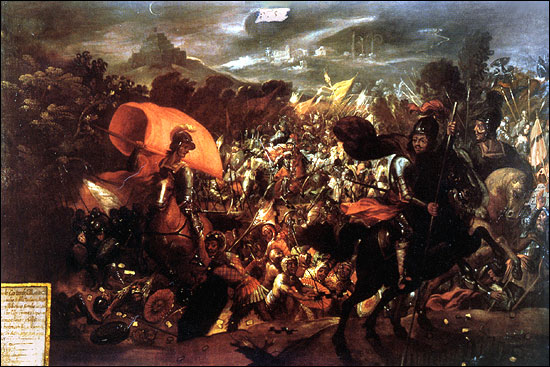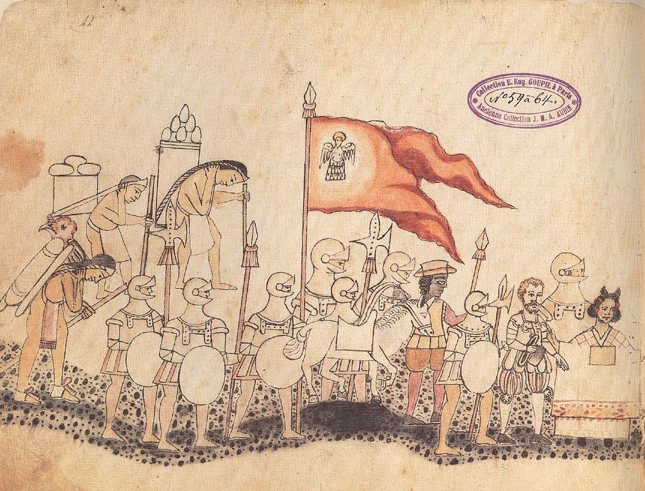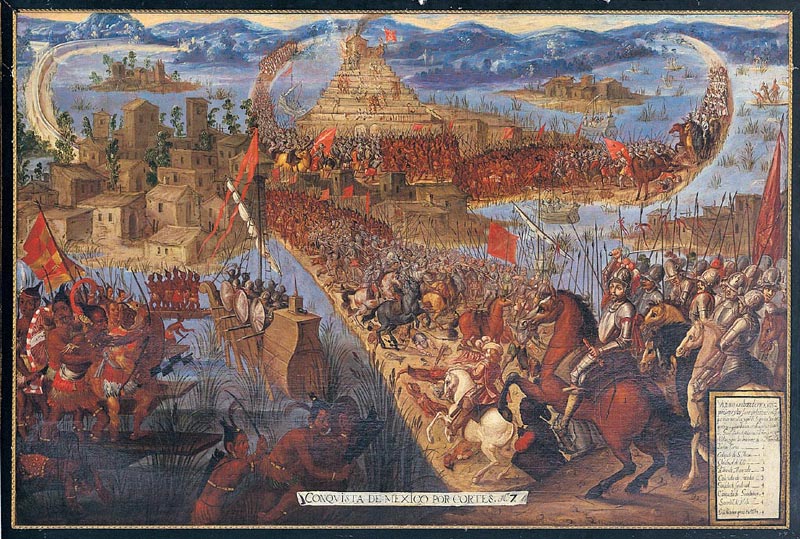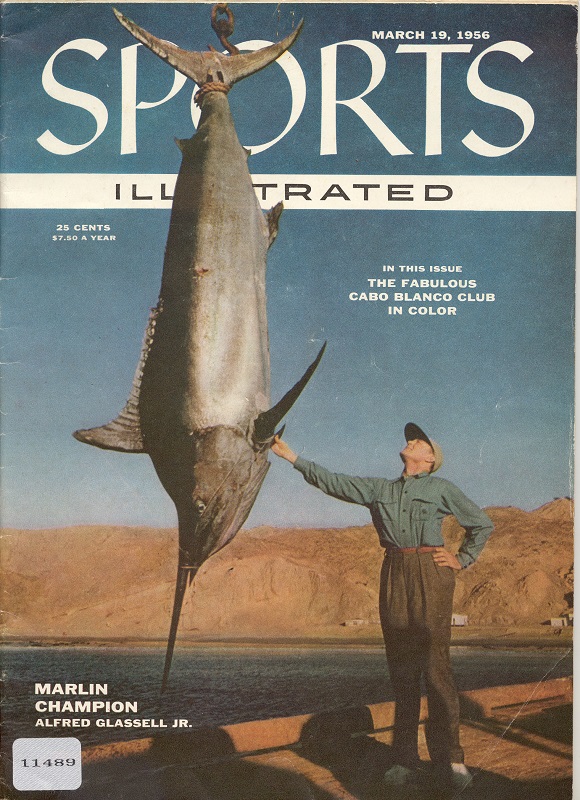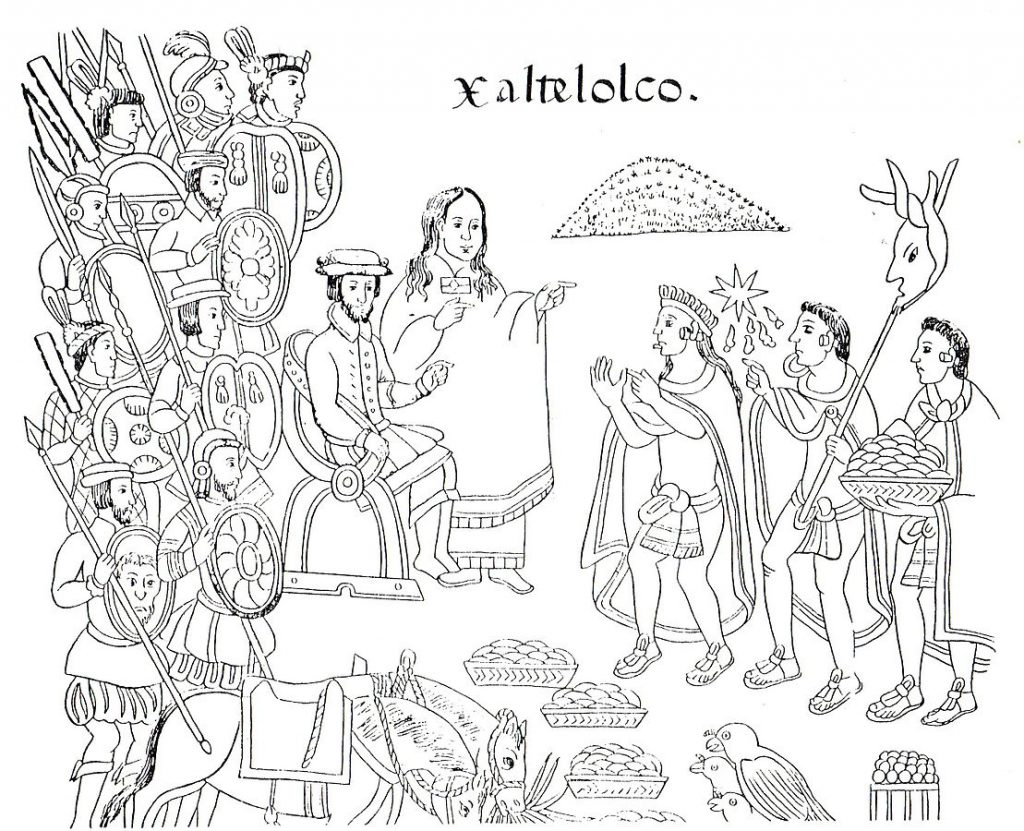
Picture from Lienzo Tlaxcala, a painting from the XV century, showing La Malinche and Hernán Cortés. Diego Muñoz Camargo, c. 1585. Source: Wikimedia Commons.
Sunday June 30, 1520, a day that will become known as La Noche Triste,“The Night of Sorrows”. The sun has set behind the rugged, volcanic peaks that ring the Valley of Mexico and there’s a light shower falling as is common in Mexico City during June. But the rain is falling on a very different city than the one that readers of this blog are familiar with. It falls on Mexico-Tenochtitlan, the grand capital of the Aztec Empire.
Tonight the Spanish forces of Hernan Cortes, who have been besieged in one of the palaces of Monteczuma for weeks since a bloody massacre on the sacred patio turned their reluctant hosts against them once an for all, will attempt to escape the city under the cover of darkness and rain.
The Spaniards have prepared a makeshift portable bridge to carry with them because Tenochtitlan is an island city, spider webbed with canals, and all of the bridges and causeways have been at least partly destroyed by the Aztec Army to make escape from the city nearly impossible.
They divide the fortune they have plundered from the Aztec Capital among themselves, loading two horses down with the treasure reserved for Charles V, King of Spain, and carrying as much as they can for themselves. They have little defense against the well trained Aztec Army, whose warriors do not fear death. The plan is to get as far as they can without being detected and when they are inevitable discovered to simply fight for their lives.
Of course, the large force of at least 500 Spaniards and more than 2000 Indigenous allies was quickly discovered and everyone was forced to run for their lives as the well-disciplined Aztec warriors quickly responded to alarms raised by citizens. The portable bridge was lost at some point during the rout through the city and when the survivors attempted to cross the Tlacopan causeway, their lifeline to the mainland, they came to an enormous gap carved into the structure by the Aztecs.
Aztec canoes filled with armed warriors surrounded them on both sides and the Spaniards and their allies were forced to jump into the water and swim across the gap. According to eyewitness accounts so many drowned that the people at the back of the formation were able to walk across the bodies of those who attempted to cross before them. The majority of the Spanish army was killed , perhaps as much as four hundred, and at least two thousand indigenous allies perished, all in one night.
This is the night that Cortes almost failed, the night that history almost changed and the night that would go down in the annals of history as the last victory of the Aztec empire. We all know what happened next: Cortes ultimately triumphs over the Aztecs and ushers in three hundred years of colonialism. But how exactly did that happen? How could the Spanish Army possibly recover from such a defeat? In fact, how did they even take Tenochtitlan in the first place? Credit is often given to the fearless intelligence of Cortes, or to the superior weapons of the Spanish or even disease. But where Cortes succeeded other Spanish expeditions, well armed with European weapons, had failed. And the first reports of disease among the Aztec are reported after Cortes had been expelled from the City. So although disease definitely played a role, there was another force, equally important in the beginning.
In this testosterone-filled tale of conquest and survival credit is rarely given to the indispensable female member of Cortes’ army. Malintzin was there that night, fleeing for her life with all those men. She was one of the few survivors. She, along with the royal treasure and a group of Aztec Noble hostages had been placed under the protection of thirty soldiers. Men had died to save her life that night.
Almost as soon as the injured and exhausted survivors arrived on the mainlabd she was called to translate in order to secure a safe harbor in one of the neighboring cities of Tenochtitlan. Already Cortes was making new allies and plotting new strikes against those who held the city he coveted above all else. Malintzin had helped her captain rise to conquer Tenochtitlan once, and now, after his defeat, she would help him do it again.
The story of Malintzin Tenepal ( a name that might or might not be her actual indigenous name, all we really know is that Malinche was a mispronunciation of whatever her real name was) is more epic than fiction. She was born an Aztec princess and died a Spanish Dona. Admittedly, this is a fate that was shared by other indigenous noblewomen because in the early days of colonization the new Spanish rulers often tried to legitimize their power by marrying into indigenous nobility. But in between her two titles, La Malinche was also a slave, translator, informant and adventurer. Some are tempted to think of her as a Mexican Pocahontas or Sacagawea, but La Malinche was different; she changed an entire nation, if not a whole hemisphere. She was indispensable to Cortes. On the night of Sorrows he, whose lust for gold and power is legendary, protected her as he protected the royal treasure.
Her life story is shrouded in mystery and speculation, but according to contemporaneous sources she was born to a noble family in the Aztec provence of Coatzacoalcos sometime around 1505. According to written accounts left behind by people who knew her personally, her father was a Cacique, an Indigenous king, and she was his heir. But when she was young her father died and her mother married another nobleman.
When her mother gave birth to a son by her new husband it became desirable that he be the heir to the throne rather than Malintzin. So it was arranged that the young princess would be kidnapped and sold into slavery far away in a Maya state called Xicalango. Her death was faked, the body of another girl was carried in a grand funeral procession, and Malintzin was forgotten.
She was around eight years old when this happened, and she would spend a decade as a slave among the Maya before being given to Cortes, along with 19 other girls, as part of what was basically a bribe to convince the Spanish to go away and leave them alone.
These Maya, belonging to a settlement in the region of Tobasco, were very keen to make Cortes happy because they had attempted to destroy the Spanish army with a surprise attack on their first arrival. But of course that had failed an now they were in a particularly awkward predicament. So they gave the Spaniards as much gold and women as they could and even allowed them to build and altar to the Virgin Mary in their city, promising to worship it and take care of it.
Malinche (christend Marina by the Spaniards) quickly proved her worth as a translator. In her captivity among the Maya she had learned to speak their language. This was of little use to Cortes at first, because he already had a Maya translator; a Spanish friar named Geronima de Aguilar who had been shipwrecked in 1511 and somehow got himself enslaved by the Maya too.
But Aguilar could not speak Nahuatl, the language of Central Mexico, and Malinche could. So by the time the Spanish landed on what would become the coast of Veracruz in search of the legendary king Monteczuma, whose kingdom Cortes plotted to take, she had asserted herself as a valuable asset to travel in the region.
Shortly after arriving, the Spanish came into contact with some of Monteczuma’s emissaries. La Malinche translated their words into Maya for Aguilar, and Aguilar translated the speech into Spanish for Cortes. It was a convoluted string of close-enough guesswork and much credit was given to La Malinche for her efforts. Bernal Diaz Del Castillo, one of Cortes’ men who later wrote a memoir of the event which is considered one of the best sources of accurate historical information on the conquest of Mexico, states that “it was through her only, under the protection of the Almighty, that many things were accomplished by us: without her we never should have understood the Mexican language, and, upon the whole, have never been able to surmount many difficulties.”
In Diaz Del Castillo’s account, Dona Marina (as he always refers to her) gets a much better treatement than Aguilar. Some scholars have suggested that la Malinche did more then simply translate Cortes’ words. They suggest that she used her familiarity with Aztec customs to “spruce up” the Spaniard’s speech. This cannot be proven, but it cannot be denied that she brought something to the table of great worth to the Spaniard. Diaz Del Castillo says in his work that Cortes never went anywhere without her.
The political climate in Central Mexico at the Time of Cortes’ arrival was very volatile. The Aztec empire wielded power over millions, but only tenuously. Uprisings were not uncommon. And there were several independent states in Mexico, like Tlaxcala, who absolutely hated the Aztec. Cortes allied himself with the Tlaxcalans and other cities he encountered on the road to Tenochtitlan, but these alliances were literally hard won. His forces fought for weeks against the Tlaxcalans before they finally submitted and agreed to an alliance that, according to Diaz Del Castillo, was called into question after La Malinche discovered Tlaxcalan spies in their camp.

Tenochtitlan, Entrance of Hernan Cortes. Cortez and La Malinche meet Moctezuma II. , November 8, 1519 The imasge is from the “Lienzo de Tlaxcala”, created by the Tlaxcalans to remind the Spanish of their loyalty to Castile and the importance of Tlaxcala during the Conquest. The text mixes European and native styles and includes anachronisms, such as the European-style chairs included in this image. Source: Wikimedia Commons
After Tlaxcala fully submitted to a Spanish alliance, they traveled to Cholula. There the Spanish were welcomed with open arms at first, but a plot so surprise attack Cortes and his army was supposedly uncovered by La Malinche. In response, the Spanish army and their Tlaxcalan allies massacred thousands of Cholulans. From then on fear encouraged many, including Monteczuma, to avoid combatting the Spanish at all costs.
The validity much of the stories of La Malinche’s heroic acts are difficult to confirm. Whose to say that Bernal Diaz Del Castillo, who wrote his work decades after the suppression of the Aztec, didn’t misremember a few things? Who’s to say he wasn’t simply trying to justify a heinous act committed by the Spanish with a made up story? But even if some of the details are not one hundred percent accurate, numerous sources describe Cortes’ dependence on La Malinche.
Indigenous eye witness accounts collected in Miguel Leon de Portilla’s work The Broken Spears describe her shouting from the rooftop of Monteczuma’s palace during Tenochtitlan’s Spanish occupation, commanding the Aztec people to bring provisions, which they did. It is a rare thing for a woman who, as far as the Aztec were concerned, was of questionable birth to command such authority. In fact, eyewitness accounts claim that both Cortes and Malintzin were called “La Malinche”. To the people of Mexico, the two people represented a single entity; manifestations of a single god. Both indigenous and Spanish chroniclers were greatly impressed with this young woman, further evidence that her charisma and intelligence pushed her to do far more than merely translate.
On the morning of July 1st, 1520 Hernan Cortes was already plotting his next move. He began by seeking aylum in the city of Tlaxcala, where he enlisted even more indigenous troops. He would later return to Tenochtitlan with brigandines, assembled by his men and armed with cannons. His forces would surround the island city in their little gunships and blast away any Aztec canoes that attempted to move troops or supplies through the city.
Then, with the Aztec isolated, he would send a huge force ripping through the city. After days of hard fighting he would finally be victorious. Cortes would dismantle the Aztec empire, millions of Native Americans would die of disease, cultures would be lost and the world would change forever. In the words of one of the very conquistadors, none of this would have been possible without the help of La Malinche.
After his victory, she would accompany Cortes on subsequent expeditions to the Yucatan and Western Mexico to quell rebellions and conquer new land. By that time she had learned to speak Spanish and acted as his sole translator. Around this time, she gave birth to a son by Cortes, named Martin. Bernal Diaz Del Castillo relates that during one of these trips she returned to the city of her birth. When she met her mother and her step brother for the first time since she was brutally abandoned, she forgave them, supposedly saying that they did not know whet they were doing at the time.
When Cuauhtémoc, the last Aztec Emperor, was executed for mysterious reasons on the road to the Yucatan, she translated his last words, lamenting the fall of his great nation, for Cortes. When she returned to her home in Central Mexico she gave birth to a daughter by Juan Jaramillo, a husband hand- picked by Cortes. Some time later (it is uncertain when precisely) she died.
The reputation of La Malinche suffers from her intimate connection with the destruction of her own culture. Scholars in the past demonized her as some sort of provocateur or temptress. They use the fact that she had a child by Cortes to support this assertion. But in reality she was a slave and if she had not done was she was asked bad things would have happened to her. Bernal Dias Del Castillo himself said that without her many things would not be accomplished. Image how isolated and vulnerable the relatively small Spanish force felt in such an alien and hostile environment. That sort of fear can provoke people to do bad things in order to preserve their safety. All of this is of course conjecture, but considering that Dona Malina didn’t leave behind a written record describing her own feelings, anything said by anyone about her thoughts and intentions is mere speculation. With this is mind we must view La Malinche not as an evil temptress or a mere victim but as a complex and tragic historic figure.
Hisotry has not forgotten La Malinche, but it has certainly blurred our view of her. She is often mentioned in historic records and eyewitness accounts, but she is always treated as a supporting character in a larger story. It could be argued, however, that the Conquest of Mexico is her story. She, who had fallen from nobility only to return with a seemingly supernatural army; who destroyed her world merely by trying to survive at the hand of her captors. Out of all of the historic figures that emerge of of the conquest, she is the most interesting.



